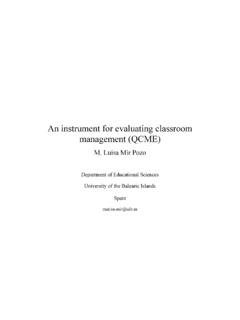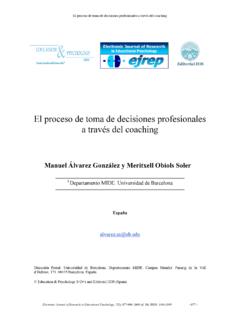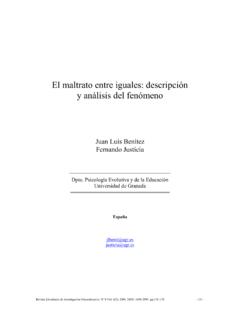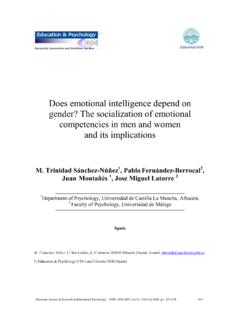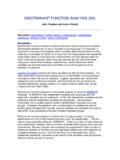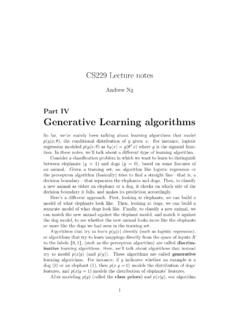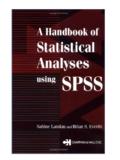Transcription of Extra-curricular activities and academic …
1 Extra-curricular activities and academic performance in secondary students Juan Antonio Moriana, Francisco Al s, Roc o Alcal , Mar a Jos Pino, Javier Herruzo, Rosario Ruiz Department of Psychology, School of Educational Sciences, University of Cordova Spain Extra-curricular activities and academic performance in secondary students . - 36 - Electronic Journal of Research in Educational Psychology. ISSN. 1696-2095. No 8, Vol 4 (1) 2006, pp: 35- 46. Abstract Introduction. In this paper we study the posible influence of Extra-curricular activities (study-related and/or sports) on academic performance of first- and second-year pupils in Educaci n Secundaria Obligatoria (ESO) [ seventh- and eighth-graders].
2 Method. We randomly selected 12 schools in the city (9 public and 3 private), and randomly chose participating pupils (222), assigning them to two groups as a function of whether they were involved in activities outside the schoolday. Thus, the first group was made up of pupils who participated in Extra-curricular activities (43 males and 68 females) and the second group contained pupils who did not (35 males and 76 females). Afterward we used analysis of vari-ance to verify whether there were significant differences in academic performance of the two groups.
3 Results. Results indicate that the group involved in activities outside the schoolday yielded better academic performance , especially those that participated in study-related activities , tutoring support or private classes, and those that participated in mixed activities (both sports and academic ). Discussion. Finally, we discuss the possible influence of Extra-curricular activities on aca-demic performance and whether such participation is advisable. Keywords: academic performance , Extra-curricular activities , secondary school. Juan Antonio Moriana et al.
4 Electronic Journal of Research in Educational Psychology. ISSN. 1696-2095. No 8, Vol 4 (1) 2006, pp: 35- 46. - 37 - Introduction Using terms like school failure or academic performance continues to be problematic since both concepts are controversial. The relationship established between the two has led to numerous criticisms and to adopting different approaches to address the issue. On one hand, an assessment of school failure, even its very name, has strong negative connotations and there are broad-based problems in drawing the borderline conceptually between failure and success (Marchesi & Hern ndez, 2003).
5 Additionally, the tendency to stigmatize the failed student, and the absence of shared responsibility in factors such as family, the media, society itself, etc., make it really difficult to take on the study of this phenomenon. And so other types of terms or labels are adopted, such as low performance pupils or lack of prepara-tion . Many causes or agents have been studied as the etiological starting point for investi-gating the phenomena of school failure or success. Most notable among these are: the role of the family, family adaptability and cohesion (Gonz lez, et al.)
6 , 2003), parental expectations (Marchesi & Mart n, 2002), social change and the media (S nchez, 1997; Pereira, 2003), the educational system, reform and policies (Marchesi, 1995; Mart nez & Miquel, 1998), and other psychological aspects such as intellectual capacity (Descals & Rivas, 2002), motivation (Navas, Sampascual & Santed, 2003; Broc, 2003), self-esteem and self-concept (Broc, 2000). Nonetheless, there seems to be agreement among most authors to explain failure from a multicausal perspective where the phenomenon is analysed at several levels, and where mul-tiple variables are involved.
7 Along these lines, Orden and Gonz lez (2005), in their review of variables that make the difference between low performance and sufficient performance , af-firm that most of these variables are modifiable through formal education. Undoubtedly, school performance has been one of the indicators or predictors most used and most related to failure. This has been assessed along traditional lines, and perhaps unfairly, from a basically quantitative viewpoint based on scores or marks obtained in differ-ent school subjects. In addition to performance , numerous variables have also been related as predictors of either failure or success as a function of the tendency or importance they have in the student s marks or scores.
8 But there are controversies not only in delimiting and relating concepts of failure and performance or in studying variables supposedly related to both. Another relevant aspect Extra-curricular activities and academic performance in secondary students . - 38 - Electronic Journal of Research in Educational Psychology. ISSN. 1696-2095. No 8, Vol 4 (1) 2006, pp: 35- 46. under investigation has been determining an adequate methodological system for studying school failure through the prediction drawn from academic performance .
9 In this effort the most-used methods are discriminant analysis, multiple linear regression or logistic regression analysis, among others (Garc a, Alvarado & Jim nez, 2000). Different activities in which students participate, both inside and outside the school it-self, are among the multiple situations or agents that can have an effect on these concepts. Extra-scholastic activities have been associated with an improved educational level, more interpersonal competencies, higher aspirations and a better attention level (Mahoney, Cairos & Farwer, 2003), increased critical thinking and personal and social maturity (Bauer & Liang, 2003), higher motivation (Hollway, 2002), and generally speaking, with great benefits that serve to bridge school activities with those performed outside the academic setting (Noam, Biancarosa & Dechausay, 2003).
10 This situation has given rise in our society to an almost massive involvement in after-school activities , activities for supporting, complementing and strengthening not only the stu-dent s school performance , but also his or her personal development and other aspects such as leisure, health, values, etc. These activities are often grouped into two well-differentiated types: extra-scholastic ( activities outside the school program) and Extra-curricular (comple-mentary activities carried on within the school setting, and generally under school auspices).

